Energy Transfer in Dy3+ and Tb3+ Double-Doped Barium Borate Glass
Abstract
1. Introduction
2. Materials and Methods
2.1. Samples
2.2. Setup
3. Results
3.1. Mass Density
3.2. Absorption and Photoluminescence Quantum Efficiency
3.3. Photoluminescence and Energy Transfer
3.4. Photoluminescence Lifetime and Energy Transfer
4. Conclusions
Author Contributions
Funding
Acknowledgments
Conflicts of Interest
References
- Bengisu, M. Borate glasses for scientific and industrial applications: A review. J. Mater. Sci. 2016, 51, 2199–2242. [Google Scholar] [CrossRef]
- Kaur, P.; Kaur, S.; Singh, G.P.; Singh, D.P. Sm3+ doped lithium aluminoborate glasses for orange coloured visible laser host material. Solid State Commun. 2013, 171, 22–25. [Google Scholar] [CrossRef]
- Soga, N.; Hirao, K.; Yoshimoto, M.; Yamamoto, H. Effects of densification on fluorescence spectra and glass structure of Eu3+ -doped borate glasses. J. Appl. Phys. 1988, 63, 4451–4454. [Google Scholar] [CrossRef]
- Auf der Maur, M.; Pecchia, A.; Penazzi, G.; Rodrigues, W.; Di Carlo, A. Efficiency Drop in Green InGaN/GaN Light Emitting Diodes: The Role of Random Alloy Fluctuations. Phys. Rev. Lett. 2016, 116, 027401. [Google Scholar] [CrossRef]
- Hagemann, V.; Seidl, A.; Weidmann, G. Static ceramic phosphor assemblies for high power, high luminance SSL-light sources for digital projection and specialty lighting. In Light-Emitting Devices, Materials, and Applications XXIV; SPIE: Bellingham, WA, USA, 2020; Volume 11302, p. 113021N. [Google Scholar] [CrossRef]
- Mariselvam, K.; Kumar, R.A. Borate Glasses for Luminescence Applications - Potential Materials for White LEDs and Laser Sources. Univers. J. Chem. 2016, 4, 55–64. [Google Scholar] [CrossRef]
- Kapoor, S.; George, H.B.; Betzen, A.; Affatigato, M.; Feller, S. Physical properties of barium borate glasses determined over a wide range of compositions. J. Non-Cryst. Solids 2000, 270, 215–222. [Google Scholar] [CrossRef]
- Grüne, M.; Rimbach, A.C.; Steinbrück, J.; Schweizer, S. Colour shift in Dy3+-doped lithium aluminoborate glass. J. Lumin. 2020, 223, 117215. [Google Scholar] [CrossRef]
- Dieke, G.H.; Crosswhite, H.M. The Spectra of the Doubly and Triply Ionized Rare Earths. Appl. Opt. 1963, 2, 675–686. [Google Scholar] [CrossRef]
- Lakshminarayana, G.; Kaky, K.; Baki, S.; Lira, A.; Caldiño, U.; Kityk, I.; Mahdi, M.A. Optical absorption, luminescence, and energy transfer processes studies for Dy3+/Tb3+-codoped borate glasses for solid-state lighting applications. Opt. Mater. 2017, 72, 380–391. [Google Scholar] [CrossRef]
- Niko, H.; Igor, M. FRET—Förster Resonance Energy Transfer: From Theory to Applications; Wiley: Hoboken, NJ, USA, 2013. [Google Scholar] [CrossRef]
- Blasse, G.; Grabmaier, B.C. Luminescent Materials; Springer: Berlin/Heidelberg, Germany, 1994. [Google Scholar] [CrossRef]
- Andrews, D.L. Mechanistic principles and applications of resonance energy transfer. Can. J. Chem. 2008, 86, 855–870. [Google Scholar] [CrossRef]
- Sun, Y.; Yu, F.; Liao, M.; Ma, J.; Wang, X.; He, D.; Gao, W.; Knight, J. Visible emission and energy transfer in Tb3+/Dy3+ co-doped phosphate glasses. J. Am. Ceram. Soc. 2020, 103, 6847–6859. [Google Scholar] [CrossRef]
- Sołtys, M.; Kos, A.; Janek, J.; Żur, L.; Pisarski, W.; Pisarska, J. Energy transfer processes between rare earth ions and white light emission in inorganic glasses. In Proceedings of the 2016 18th International Conference on Transparent Optical Networks (ICTON), Trento, Italy, 10–14 July 2016; pp. 1–4. [Google Scholar] [CrossRef]
- Kumari, P.; Dwivedi, Y. Bright emission via energy transfer from Dy to Tb in Bi2SiO5 nanophosphor. Opt. Mater. 2017, 75, 31–37. [Google Scholar] [CrossRef]
- Sherawat, R.; Rao, A. Effective energy transfer from Dy3+ to Tb3+ ions in thermally stable KZABS glasses for intense green emitting device applications. J. Lumin. 2021, 239, 118325. [Google Scholar] [CrossRef]
- Vijayakumar, M.; Viswanathan, K.; Marimuthu, K. Structural and optical studies on Dy3+:Tb3+ co-doped zinc leadfluoro-borophosphate glasses for white light applications. J. Alloys Compd. 2018, 745, 306–318. [Google Scholar] [CrossRef]
- Wan, X.; Lin, Y.Q.; Tie, S.L.; Shen, J.Y. Luminescence and energy transfer in Dy3+/Tb3+ co-doped CaO–Al2O3–B2O3–RE2O3 glass. J. Non-Cryst. Solids 2011, 357, 3424–3429. [Google Scholar] [CrossRef]
- Pisarska, J.; Kos, A.; Pisarski, W. Spectroscopy and energy transfer in lead borate glasses doubly doped with Dy3+-Tb3+ and Tb3+-Eu3+ ions. Spectrochim. Acta. Part A Mol. Biomol. Spectrosc. 2014, 129, 649–653. [Google Scholar] [CrossRef] [PubMed]
- Sun, X.Y.; Gua, M.; Huang, S.M.; Liu, X.L.; Liu, B.; Ni, C. Enhancement of Tb3+ emission by non-radiative energy transfer from Dy3+ in silicate glass. Phys. B Condens. Matter 2009, 404, 111–114. [Google Scholar] [CrossRef]
- Pisarska, J.; Kos, A.; Pietrasik, E.; Pisarski, W. Energy transfer from Dy3+ to Tb3+ in lead borate glass. Mater. Lett. 2014, 129, 146–148. [Google Scholar] [CrossRef]
- Förster, T. Zwischenmolekulare Energiewanderung und Fluoreszenz. Ann. Der Phys. 1948, 437, 55–75. [Google Scholar] [CrossRef]
- Reisfeld, R.; Greenberg, E.; Velapoldi, R.; Barnett, B. Luminescence Quantum Efficiency of Gd and Tb in Borate Glasses and the Mechanism of Energy Transfer between Them. J. Chem. Phys. 1972, 56, 1698. [Google Scholar] [CrossRef]
- Grüne, M.; Schweizer, S. Comparison of Dy3+-doped barium borate and lithium aluminoborate glass. Opt. Mater. 2022, 128, 112339. [Google Scholar] [CrossRef]
- Inokuti, M.; Hirayama, F. Influence of Energy Transfer by the Exchange Mechanism on Donor Luminescence. J. Chem. Phys. 1965, 43, 1978. [Google Scholar] [CrossRef]
- Loos, S.; Steudel, F.; Ahrens, B.; Schweizer, S. Temperature-dependent luminescence and energy transfer properties of Tb3+ and Eu3+ doped barium borate glasses. J. Lumin. 2017, 181, 31–35. [Google Scholar] [CrossRef]
- Padlyak, B.; Drzewiecki, A. Spectroscopy of the CaB4O7 and LiCaBO3 glasses, doped with terbium and dysprosium. J. Non-Cryst. Solids 2013, 367, 58–69. [Google Scholar] [CrossRef]
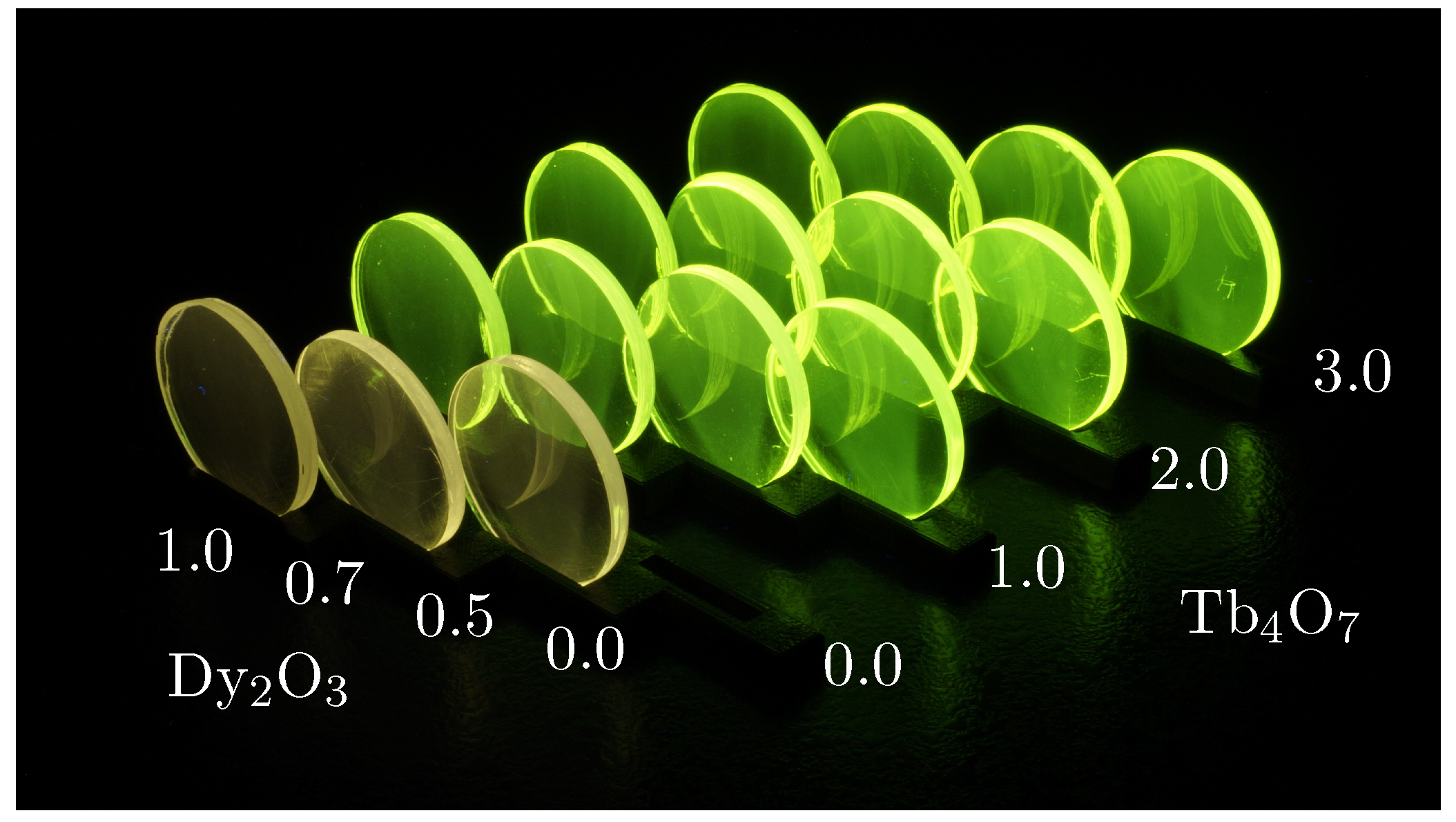

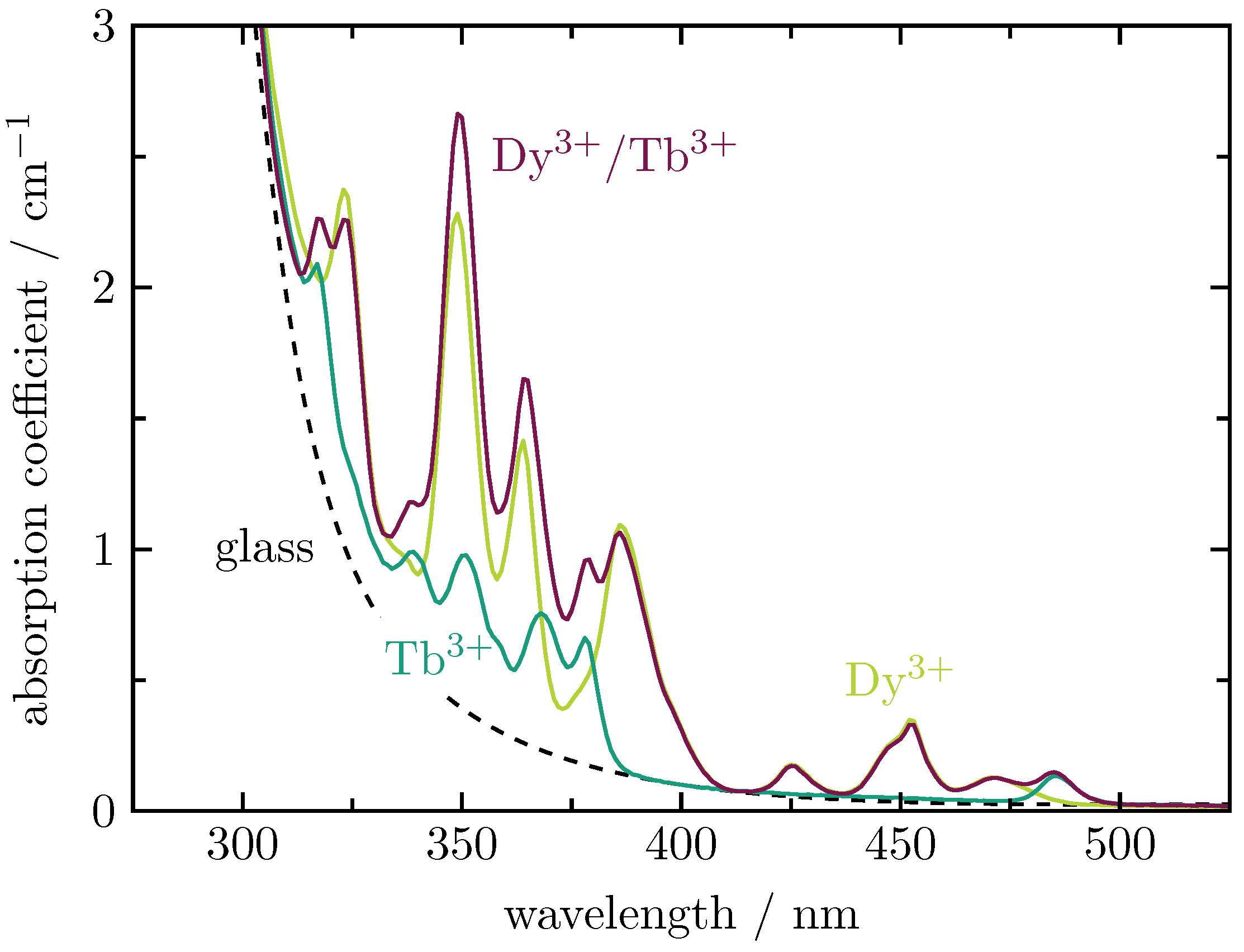
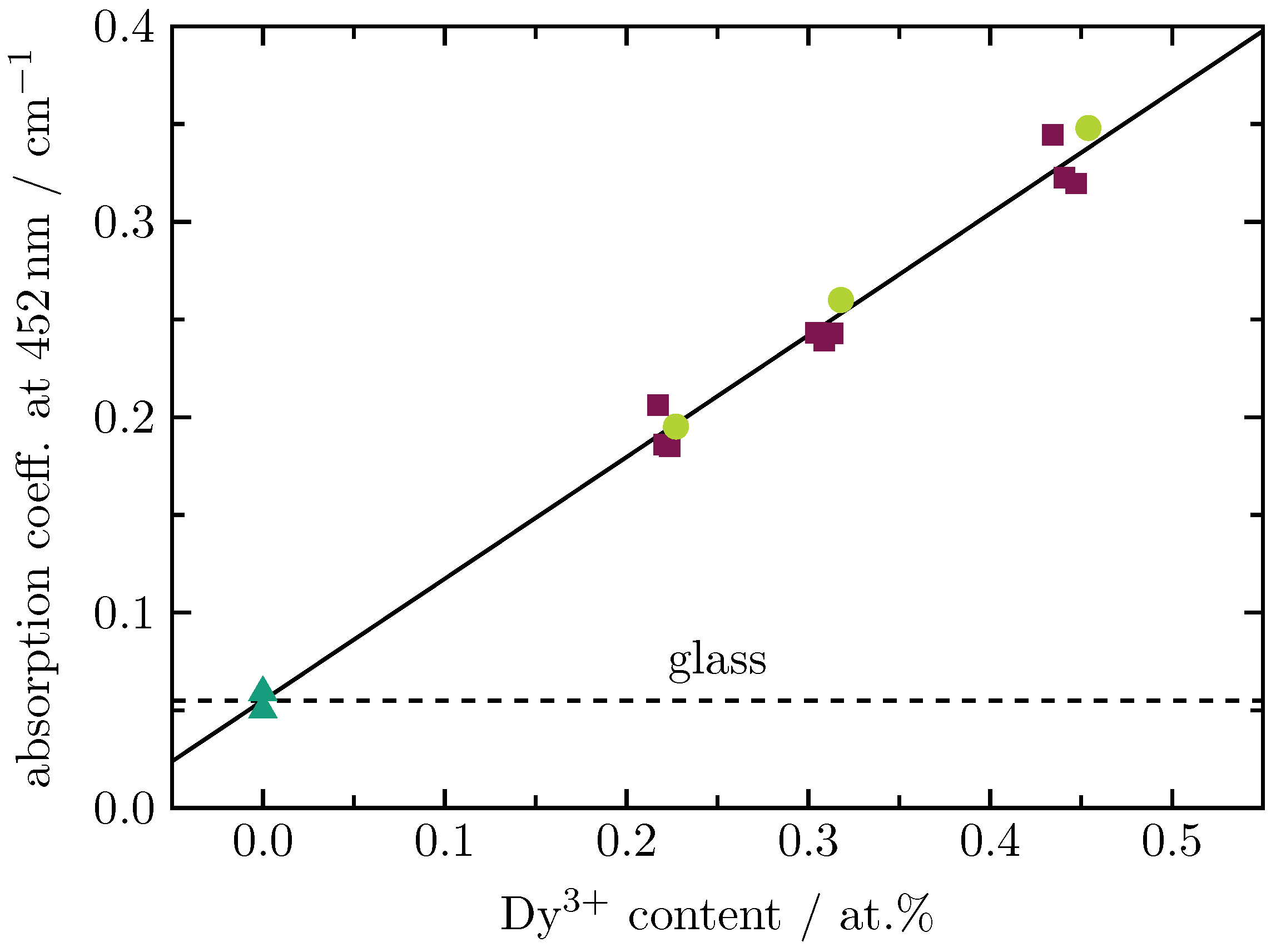

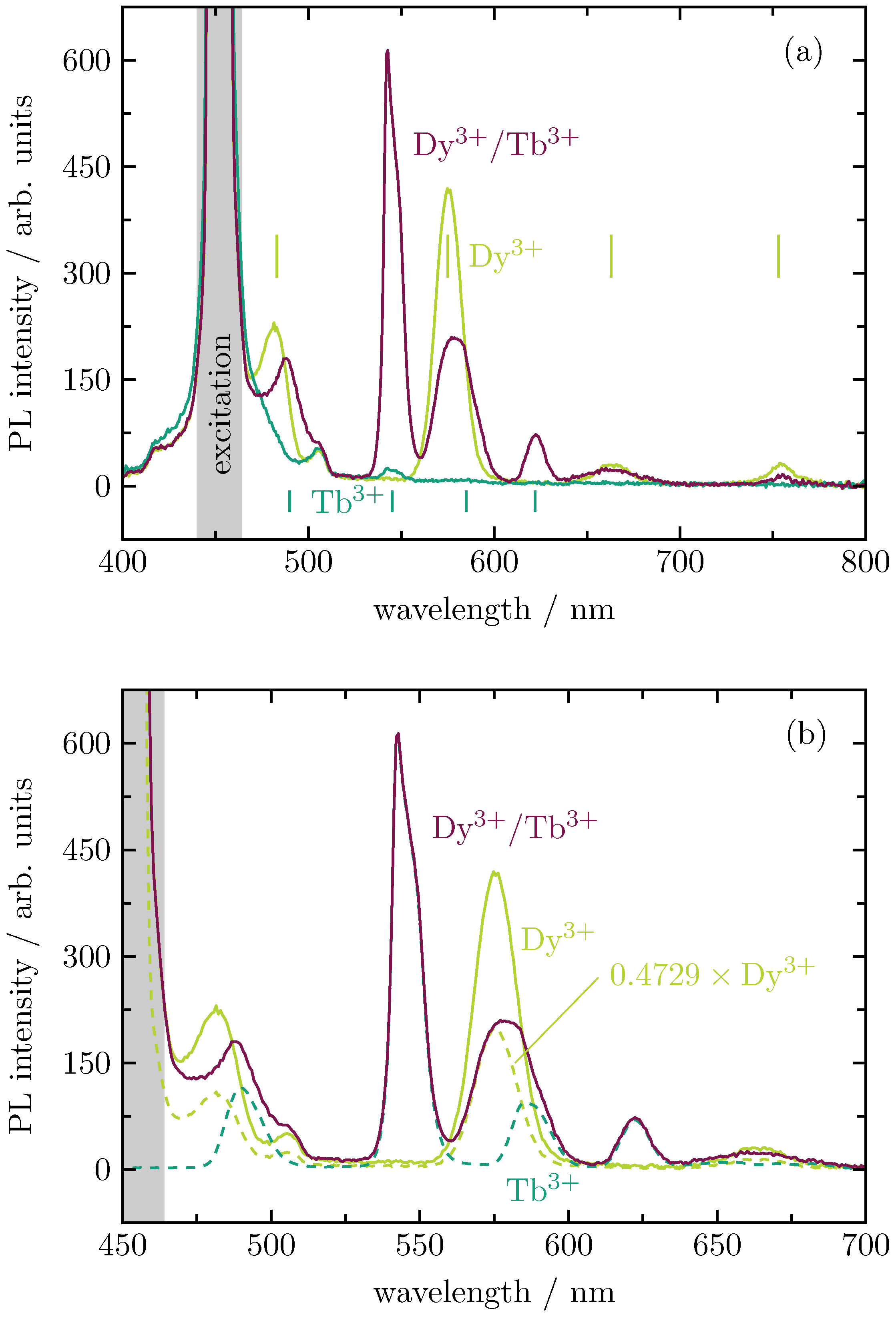
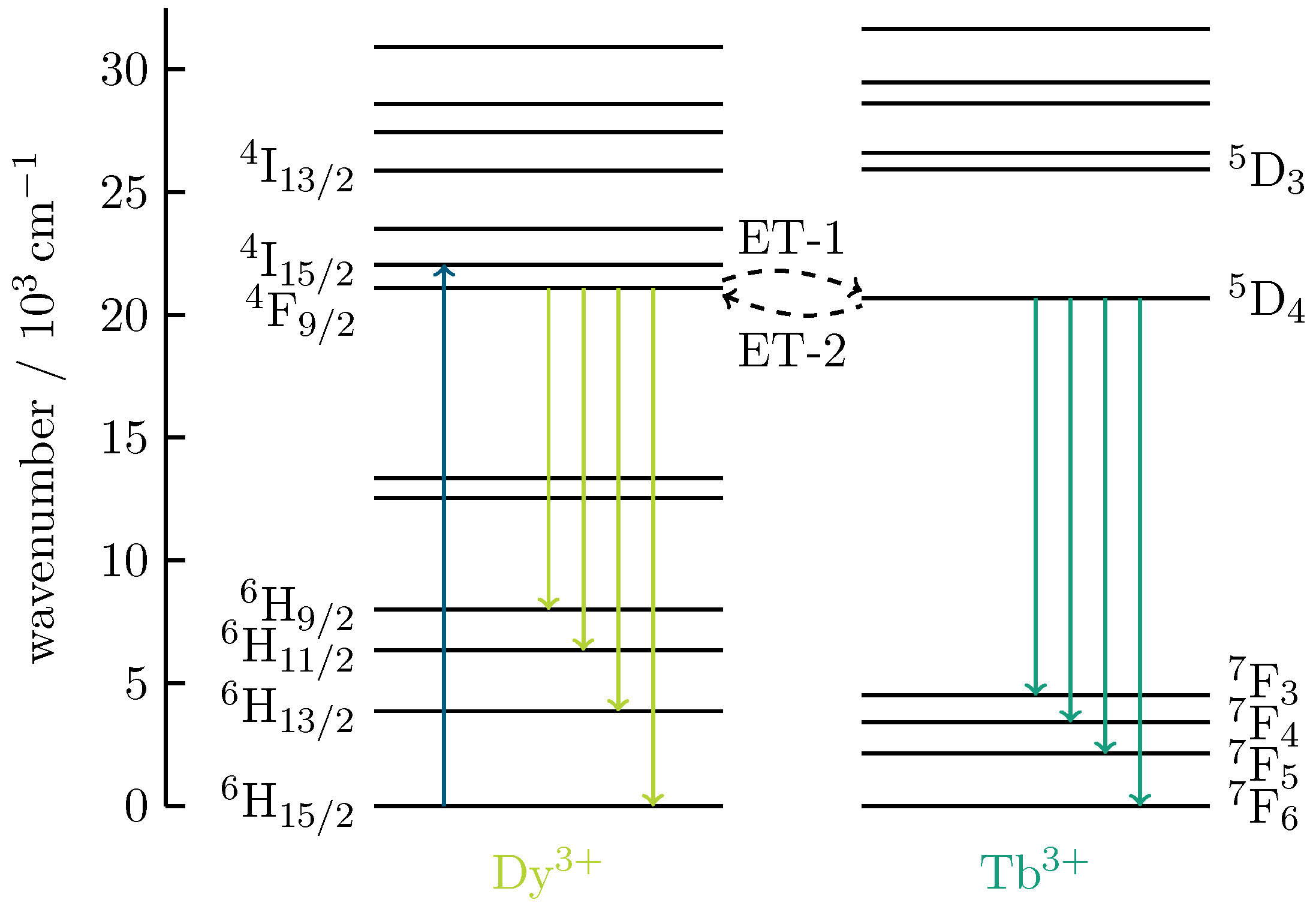


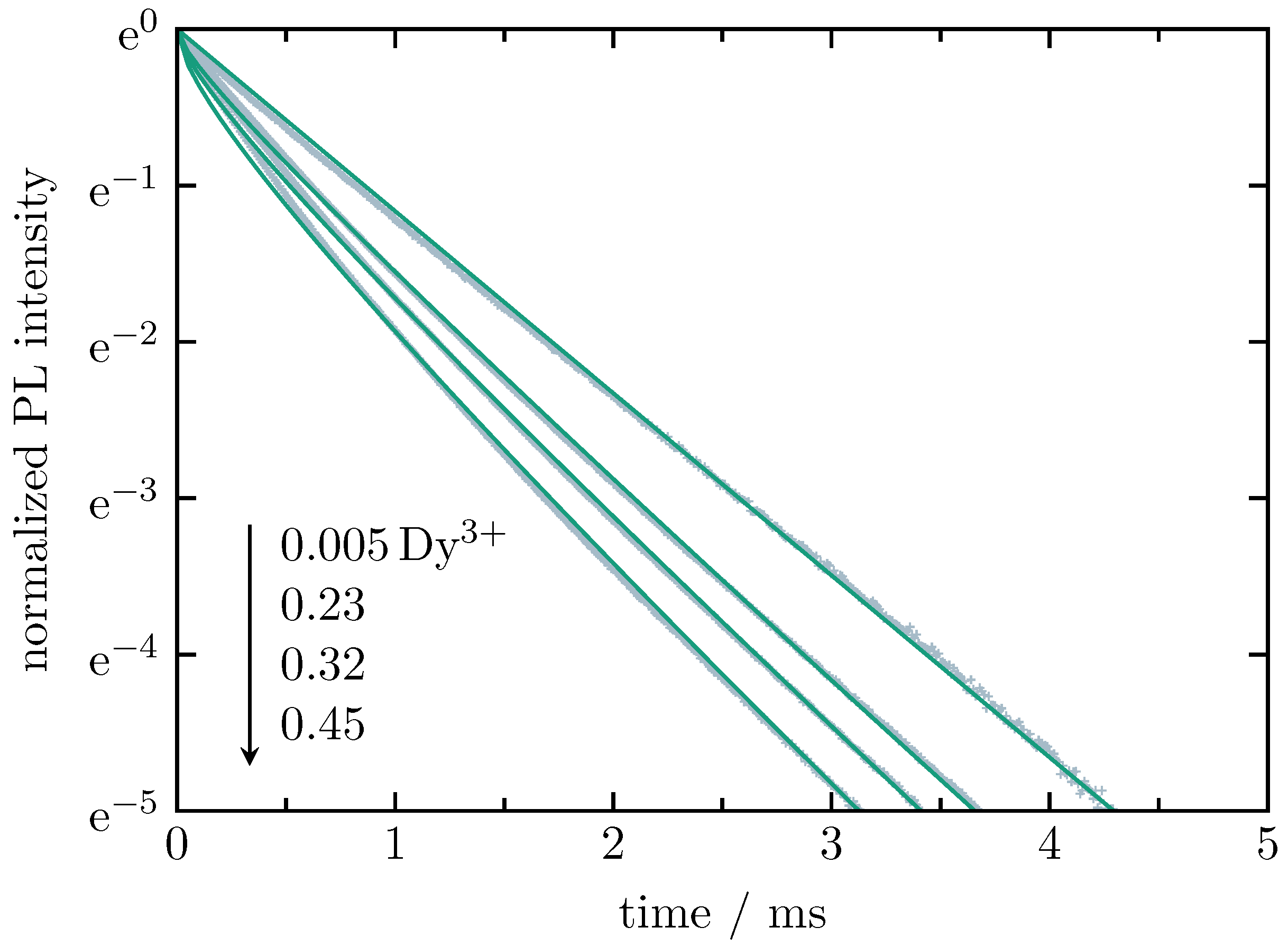
| Composition in mol% | La Content in at.% | Mass Density | Molar Mass | Molar Volume | ||||
|---|---|---|---|---|---|---|---|---|
| BO | BaO | DyO | TbO | Dy | Tb | In g/cm | In g/mol | In cm |
| 79.60 | 19.90 | 0.5 | – | 0.23 | – | 2.906 | 187.79 | 30.21 |
| 78.80 | 19.70 | 0.5 | 1.0 | 0.22 | 0.90 | 3.088 | 194.41 | 30.57 |
| 78.00 | 19.50 | 0.5 | 2.0 | 0.22 | 1.76 | 3.281 | 101.02 | 30.79 |
| 77.20 | 19.30 | 0.5 | 3.0 | 0.22 | 2.61 | 3.491 | 107.63 | 30.83 |
| 79.44 | 19.86 | 0.7 | – | 0.32 | – | 2.895 | 188.37 | 30.53 |
| 78.64 | 19.66 | 0.7 | 1.0 | 0.31 | 0.89 | 3.112 | 194.98 | 30.52 |
| 77.84 | 19.46 | 0.7 | 2.0 | 0.31 | 1.76 | 3.305 | 101.59 | 30.74 |
| 77.04 | 19.26 | 0.7 | 3.0 | 0.30 | 2.61 | 3.496 | 108.21 | 30.96 |
| 79.20 | 19.80 | 1.0 | – | 0.45 | – | 2.928 | 189.23 | 30.47 |
| 78.40 | 19.60 | 1.0 | 1.0 | 0.45 | 0.89 | 3.145 | 195.84 | 30.47 |
| 77.60 | 19.40 | 1.0 | 2.0 | 0.44 | 1.76 | 3.357 | 102.45 | 30.52 |
| 76.80 | 19.20 | 1.0 | 3.0 | 0.43 | 2.61 | 3.513 | 109.07 | 31.04 |
| 79.99 | 20.00 | – | 0.01 | – | 0.009 | 2.824 | 186.43 | 30.61 |
| 79.20 | 19.80 | – | 1.0 | – | 0.90 | 3.035 | 192.97 | 30.63 |
| 78.40 | 19.60 | – | 2.0 | – | 1.77 | 3.236 | 199.59 | 30.77 |
| 77.60 | 19.40 | – | 3.0 | – | 2.61 | 3.446 | 106.20 | 30.82 |
| Dy | Tb | EQE | |||||
|---|---|---|---|---|---|---|---|
| In at.% | In at.% | In 10cm | In nm | In cm | In % | In % | |
| 0.23 | – | 0.195 | 28 | – | – | ||
| 0.22 | 0.90 | 15.91 | 1.19 | 0.185 | 30 | 0.3840 | 62 |
| 0.22 | 1.76 | 19.78 | 1.01 | 0.186 | 35 | 0.1922 | 81 |
| 0.22 | 2.61 | 13.67 | 0.90 | 0.206 | 32 | 0.1005 | 90 |
| 0.32 | – | 0.260 | 21 | – | – | ||
| 0.31 | 0.89 | 16.71 | 1.14 | 0.243 | 25 | 0.4249 | 58 |
| 0.31 | 1.76 | 10.58 | 0.98 | 0.239 | 28 | 0.2224 | 78 |
| 0.30 | 2.61 | 14.40 | 0.89 | 0.243 | 26 | 0.1224 | 88 |
| 0.45 | – | 0.348 | 13 | – | – | ||
| 0.45 | 0.89 | 17.90 | 1.08 | 0.320 | 18 | 0.4729 | 53 |
| 0.44 | 1.76 | 11.84 | 0.95 | 0.323 | 20 | 0.2556 | 74 |
| 0.43 | 2.61 | 15.52 | 0.86 | 0.345 | 17 | 0.1467 | 85 |
| – | 0.90 | 0.059 | 2 | – | – | ||
| – | 1.77 | 0.050 | 3 | – | – | ||
| – | 2.61 | 0.059 | 4 | – | – |
| Exc./ | DyO | TbO | Dy | Tb | S | ||||
|---|---|---|---|---|---|---|---|---|---|
| Det. | In mol% | In mol% | In at.% | In at.% | In ms | In ms | In % | ||
| – | 0.01 | – | 0.01 | 2.86 | |||||
| 375 nm/ | – | 1.0 | – | 0.90 | 2.67 | ||||
| 545 nm | – | 2.0 | – | 1.77 | 2.54 | ||||
| – | 3.0 | – | 2.61 | 2.44 | |||||
| 0.5 | 1.0 | 0.22 | 0.90 | 1.73 | 0.491 | 4.55 | 35 | ||
| 0.7 | 1.0 | 0.31 | 0.89 | 1.57 | 2.67 | 0.598 | 4.50 | 41 | |
| 1.0 | 1.0 | 0.45 | 0.89 | 1.37 | 0.765 | 4.67 | 49 | ||
| 455 nm/ | 0.5 | 2.0 | 0.22 | 1.76 | 1.70 | 0.447 | 3.88 | 33 | |
| 545 nm | 0.7 | 2.0 | 0.31 | 1.76 | 1.47 | 2.54 | 0.640 | 4.04 | 42 |
| 1.0 | 2.0 | 0.44 | 1.76 | 1.22 | 0.884 | 4.24 | 52 | ||
| 0.5 | 3.0 | 0.22 | 2.61 | 1.45 | 0.610 | 3.68 | 41 | ||
| 0.7 | 3.0 | 0.30 | 2.61 | 1.25 | 2.44 | 0.834 | 3.88 | 49 | |
| 1.0 | 3.0 | 0.43 | 2.61 | 0.96 | 1.195 | 4.20 | 61 | ||
| 0.01 | – | 0.005 | – | 0.86 | |||||
| 455 nm/ | 0.5 | – | 0.23 | – | 0.61 | 0.359 | 6 | ||
| 575 nm | 0.7 | – | 0.32 | – | 0.55 | 0.86 | 0.516 | 6 | |
| 1.0 | – | 0.45 | – | 0.47 | 0.712 | 6 |
Disclaimer/Publisher’s Note: The statements, opinions and data contained in all publications are solely those of the individual author(s) and contributor(s) and not of MDPI and/or the editor(s). MDPI and/or the editor(s) disclaim responsibility for any injury to people or property resulting from any ideas, methods, instructions or products referred to in the content. |
© 2023 by the authors. Licensee MDPI, Basel, Switzerland. This article is an open access article distributed under the terms and conditions of the Creative Commons Attribution (CC BY) license (https://creativecommons.org/licenses/by/4.0/).
Share and Cite
Grüne, M.; Schweizer, S. Energy Transfer in Dy3+ and Tb3+ Double-Doped Barium Borate Glass. Materials 2023, 16, 2596. https://doi.org/10.3390/ma16072596
Grüne M, Schweizer S. Energy Transfer in Dy3+ and Tb3+ Double-Doped Barium Borate Glass. Materials. 2023; 16(7):2596. https://doi.org/10.3390/ma16072596
Chicago/Turabian StyleGrüne, Michelle, and Stefan Schweizer. 2023. "Energy Transfer in Dy3+ and Tb3+ Double-Doped Barium Borate Glass" Materials 16, no. 7: 2596. https://doi.org/10.3390/ma16072596
APA StyleGrüne, M., & Schweizer, S. (2023). Energy Transfer in Dy3+ and Tb3+ Double-Doped Barium Borate Glass. Materials, 16(7), 2596. https://doi.org/10.3390/ma16072596





